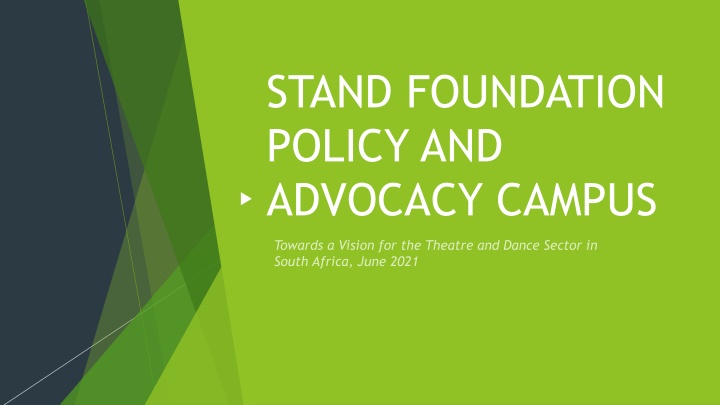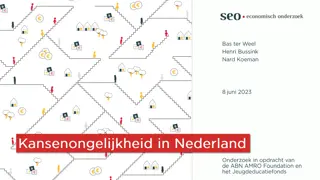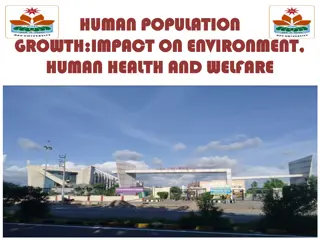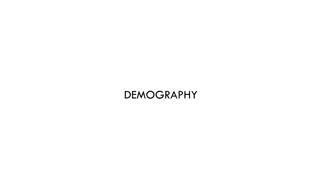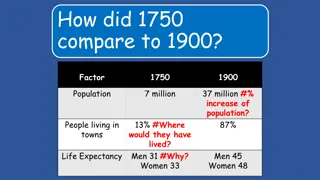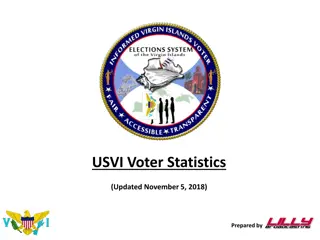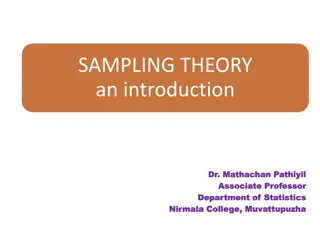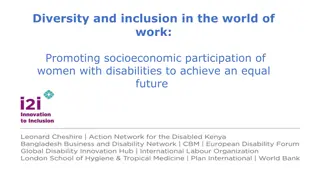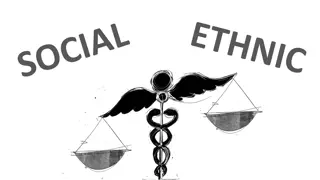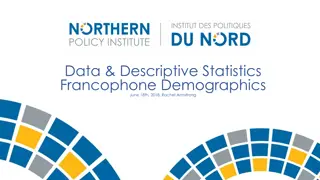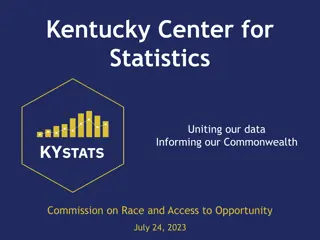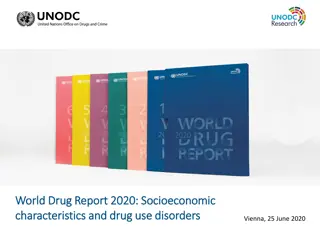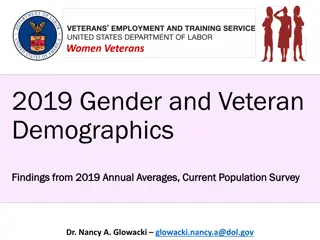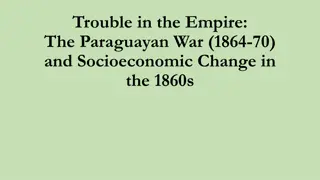Current Population Demographics and Socioeconomic Statistics
This data provides insights into the current population demographics, income disparities, unemployment rates, and poverty distribution in South Africa, highlighting challenges and disparities across provinces and population groups.
Download Presentation

Please find below an Image/Link to download the presentation.
The content on the website is provided AS IS for your information and personal use only. It may not be sold, licensed, or shared on other websites without obtaining consent from the author.If you encounter any issues during the download, it is possible that the publisher has removed the file from their server.
You are allowed to download the files provided on this website for personal or commercial use, subject to the condition that they are used lawfully. All files are the property of their respective owners.
The content on the website is provided AS IS for your information and personal use only. It may not be sold, licensed, or shared on other websites without obtaining consent from the author.
E N D
Presentation Transcript
STAND FOUNDATION POLICY AND ADVOCACY CAMPUS
Country Context Current Population: 59,62 m in mid-2020 Increased from 40,5 m in 1996 when the first White Paper on Arts, Culture and Heritage was adopted.
Breakdown per province (2019) Province Number % of total Province Number % of total Gauteng 15,18m 25,8% Mpumalanga 4,59m 7,8% Kwazulu Natal 11,29m 19,2% North West 4,03m 6,8% Western Cape 6,84m 11,6% Free State 2,89m 4,9% Eastern Cape 6,71m 11,4% Northern Cape 1,26m 2,1% Limpopo 5,98m 10,17% TOTAL 58,78m 100%
Current population Black African Coloured White Asian/Indian TOTAL 47,44m 5,18m 4.65m 1,5m 58.78m 80,7% 8.8% 7,9% 2,6% 100%
STATS SA 2020 Report on average monthly incomes per population group Black Africans: R6899 Inequality, Poverty and Unemployment Coloureds: R9339 Indians: R14 235 Whites: R24 646 Inequality: 20% of the population earns 70% of national income Bottom 40% make do with 7% of national income
Unemployment Narrow definition: 32,5% Extended definition: 43,2% Last quarter of 2020 Unemployment 15m employed 7,2m unemployed 64% of the population is under 35 63% of 15-24 year-olds (job seekers) are unemployed
Limpopo: 67,5% Eastern Cape: 67,3% Distribution of poverty per province (less than R2400 per month, or R80 per day) KwaZulu Natal: 60,7% North West: 59,6% Mpumalanga: 54,6% Northern Cape: 54,3% Free State: 48,9% Western Cape: 33,2% Gauteng: 29,3% 60% of households are more dependent on social grants than on income derived through the labour market
Internet access More than 60% of the population has access to the internet However, less than 10% have access to the internet at home High costs of data mean that the internet is used more functionally rather than for browsing/surfing/streaming
Assumptions: Everyone shall have the right freely to participate in the cultural life of the community and to have access to the arts (Article 27 of the Universal Declaration of Human Rights) Publicly-funded infrastructure, resources, funding, skills need to be more equitably distributed, and particularly to less-resourced provinces and communities Implications Online platforms to distribute theatre still relatively elitist Formal theatre industry dependent on a relatively small, but moneyed, market with disposable income (less than 20% of SA, but still 12m people)
Total Country Budget: R980 883,9 billion for 41 departments/entities Dept of Sport, Arts and Culture Budget (2021/22) Dept Sport, Arts and Culture: R5 693,9 billion 19thof 41 entities 0,58% of budget
Programme Amount Percentage Administration 440,1 7,7% Recreation and Sport 1 441,8 25,3% Arts and Culture Promotion 1 248,8 21, 9% Heritage 2 527,2 44,4% TOTAL 5 693,9 100% Department of Sports, Arts and Culture Budget
Provincial location of nationally- subsidized theatres Gauteng: three (State Theatre, Market Theatre, Windybrow Theatre latter two amalgamated) Western Cape, KwaZulu Natal, Free State, Eastern Cape: one each None in: Limpopo (Poverty ranking: 1), North West (4), Mpumalanga (5), Northern Cape (6)
Theatres Subsidies Theatre Artscape State Theatre Playhouse PACOFS Market Theatre TOTAL Nelson Mandela Bay Theatre Upgrading community arts centres TOTAL ON INFRASTRUCTURE Subsidy 65 849 61 247 53 866 48 823 51 216 281 001 13 000 Capital 10 798 10 006 12 695 7 034 8 268 48 801 Total 76 647 71 253 66 561 55 857 59 484 329 802 13 000 11 137 353 937 11 137
DSAC budget of relevance to theatre (and dance): Funding agencies Entity Amount (2021/22) National Arts Council R120,137m National Film and Video Foundation R145,920m Business and Arts South Africa R 10,291m Mzansi Golden Economy R322 449m
Given the triple challenges of inequality, poverty and unemployment, government speaks of itself and of its policies as the developmental state The Developmental State the state plays an active role in guiding the economy (rather than simply leaving economic development to the market ) it seeks to balance economic growth with social development it deploys state resources and influence to address poverty and expand opportunities
Theatre for Human Development Theatre for emotional, psychological, spiritual catharsis Theatre as an expression of the right to freedom of expression Towards a vision for theatre in the context of a developmental state Theatre as having value in its own right, not related to market value Theatre that survives through a combination of subsidy, sponsorship and box-office Theatre for Social Development Theatre for socially-good ends (e.g. health, anti-xenophobia, anti-GBV education) Audiences that are subsidized rather than paying markets Theatre for Economic Development Theatre that entertains (musicals, stand- up comedy, etc) Theatre that survives and profits in the market-place
15 theatre and 15 dance companies, each receiving an average subsidy of R3,5 million per year, in cycles of up to 3 years Shift from funding infrastructure to funding companies Different tiers allocating funds and length of time according to set criteria 3 companies in each form in each of Gauteng and KZN, two of each in WC and EC and one of each in Limpopo, Mpumalanga, North West, Northern Cape and Free State (based on provincial populations) Average of 12 per company X 30 companies: 360 employed @ R105m Companies to tour province, schools, non-traditional theatre spaces taking theatre and dance to people in addition to formal space seasons
Current state-subsidized infrastructure is expensive and is it appropriate/necessary to our times? To be evaluated. National circuit of venues, at least one per province to facilitate national tours Additionally, independent theatres to be able to apply for grants to stage work Infrastructure Community arts centres to be developed, supported by provincial and local governments Subsidised companies to be given first option to be based at national circuit venues, but as independent companies
Productions, commissions and touring Choreographers, directors, playwrights, designers, etc to have 3- 12 month residencies at subsidized theatres and companies Festivals that commission new work to be subsidized and to form part of a national circuit with venues to co- produce and tour work No state-subsidized institution to have an artistic director for longer than 5 years International touring fund to support South African theatre and dance at international festivals, venues Funds to be set aside particularly for national tours
Each province to have at least one tertiary institution offering diploma, certificate and degree courses in dance and theatre (acting, dancing, directing, playwriting, design, etc) managers (venues, festivals), producers technicians, stage managers entrepreneurs (marketing, publicity, etc) theoreticians (researchers, archivists, art journalists/critics, etc) educators/teachers Education and Training
Artists rights and social benefits Sectoral determination to maintain independent contractor status while benefiting from Labour Relations Act protections Standard contracts, minimum remuneration rates and a Code of Conduct Medical aid, UIF and benefits for old age and disability Retirement homes Appropriate taxation Labour/Sector Ombudsman
There is public funding for theatre and dance We have infrastructure We have world-class talent in theatre and dance There is more that can and should be done Conclusion We need government with vision and political will at all 3 levels The theatre and dance sector needs actively to work together to advocate for and defend its interests The full document is at www.standfoundation.org.za
